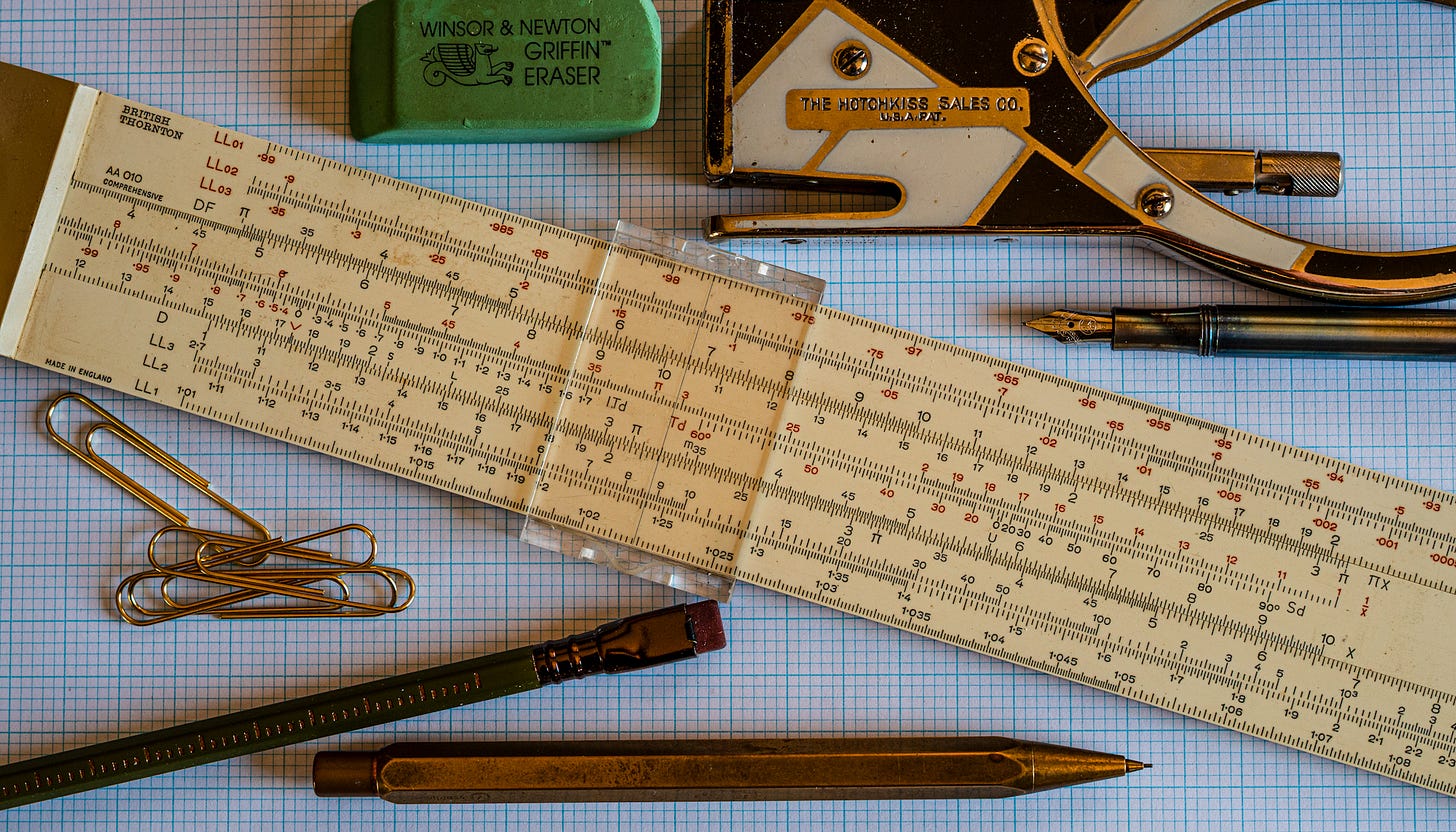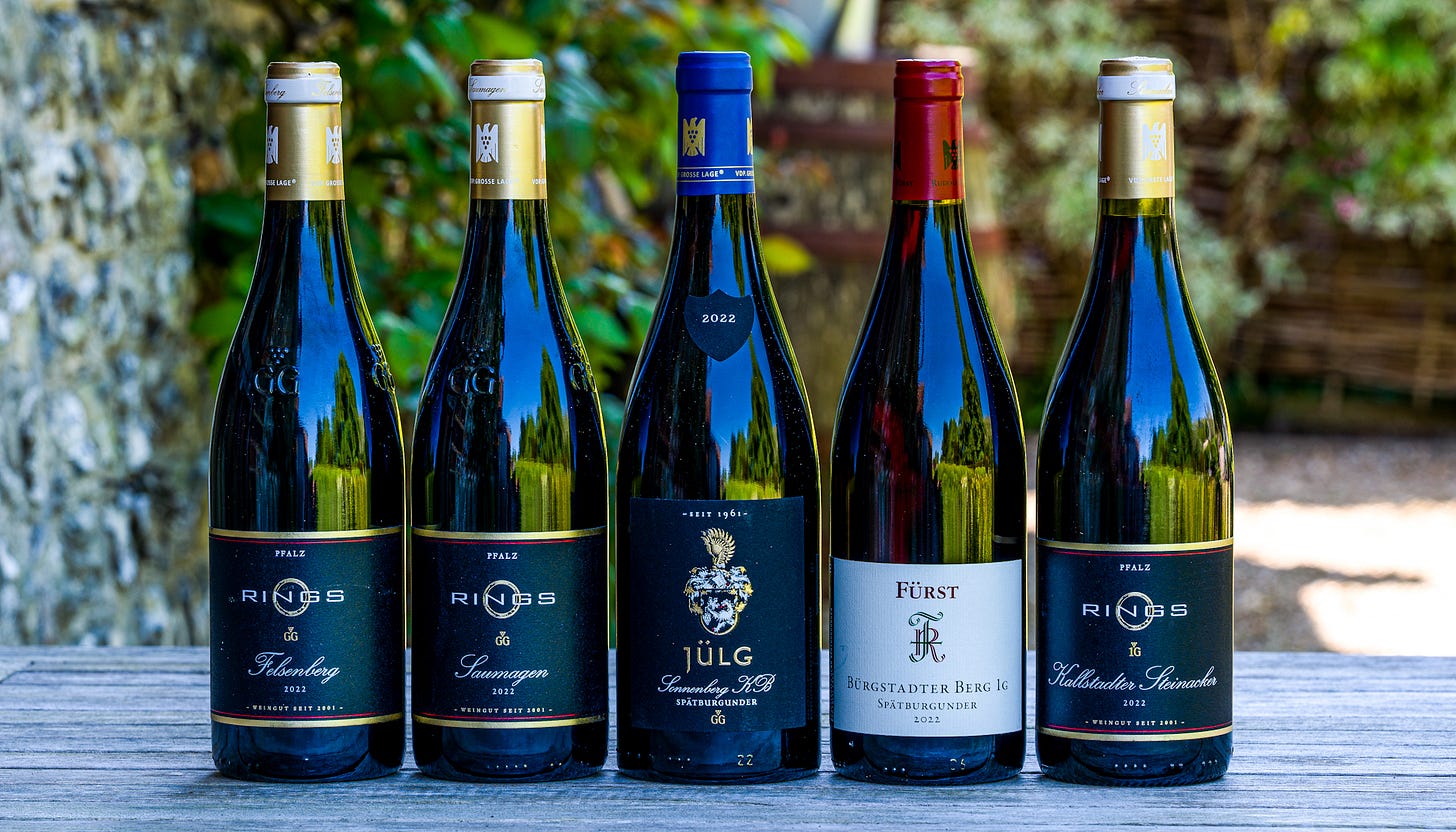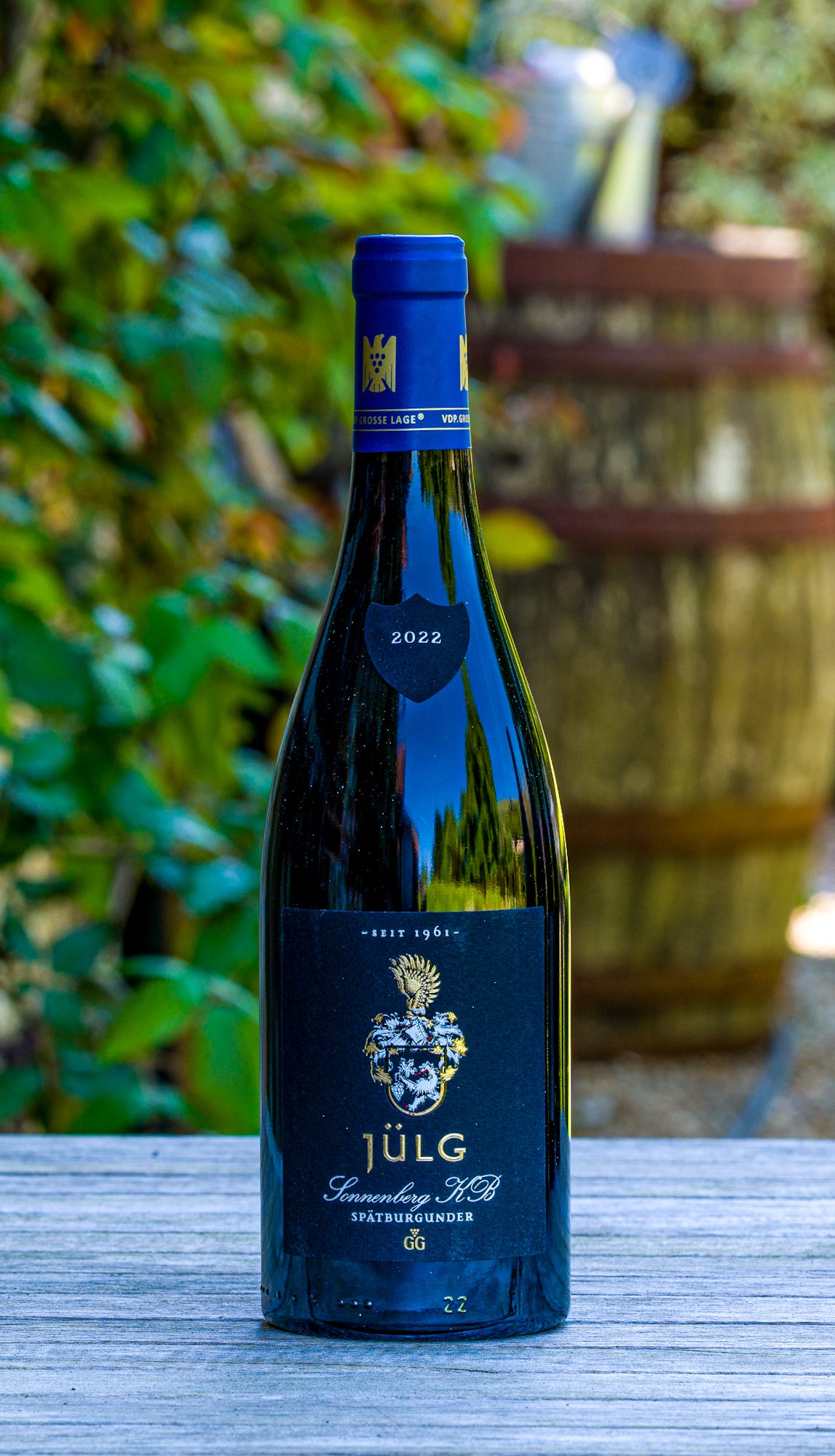Benchmarking: German Pinot Noirs
… high quality Spätburgunder …
Following a visit to a wine trade fair in Mainz a couple of weeks ago, I attended a Masterclass on German Pinot Noirs. It is easy to forget that not only does Germany create some of the world’s finest Rieslings, but their reds, at the top end of the quality arena, can rival Burgundy, Oregon, and Central Otago.
The wines presented that morning all came from the 2022 vintage, but sadly are not available in the UK. However, a collection of 5 German 2022 Pinots were assembled to evaluate alongside three other 2022 Pinots from Burgundy, South Africa and New Zealand. This panel tasting became a ‘benchmarking’ exercise. Did the German wines deliver quality and value alongside other wines that had been tried and tested?
The German wines in the panel tasting were
Weingut Rings, Kallstadter Steinacker 1G, 2022, Pfalz - £63.46
Weingut Rudolf Fürst, Burgstädter Berg Spätburgunder 1G, 2022, Franken - £63.46
Weingut Jülg, Spätburgunder Sonnenberg Kammerberg GG, 2022, Pfalz - £87.46
Weingut Rings, Saumagen Spätburgunder GG, 2022, Palz - £99.46
Weingut Rings, Felsenberg Spätburgunder GG, 2022, Pfalz - £111.46
They were pitched against:
Mt Difficulty, Bannockburn, Central Otago, New Zealand 2022 - £31.00 - This wine that had outperformed a host of other Pinots from the Pacific Rim at a recent panel tasting.
Art of Creation Pinot Noir, Creation Winery, 2022- Hemel-en-Aarde , South Africa - £65.00 - I wrote extensively about this winery following a visit in February.
Domaine Heresztyn-Mazzini, Morey Saint Denis 1er Cru Les Millandes, 2022 - £106.00 - A wine I had bought at an en primer tasting and was conveniently sitting in the cellar.
Howard Ripley was the source of the Spätburgunder (German for Pinot Noir, the bedrock of red Burgundy). I first met Howard in the mid-80s at a lunch organised by Liz and Mike Berry who were then running the retail wine emporium, La Vigneronne in South Kensington. He was a dentist at the time, but had started importing wines and then established this excellent wine merchant and, although now retired, his company continues to be a very good source of specialist German wines.
All the German Pinots performed extremely well in terms of quality and, very, very importantly, value alongside the other three benchmark wines. However, the brief for the panel was to identify one wine:
Weingut Jülg, Spätburgunder Sonnenberg Kammerberg GG, 2022, Pfalz
£87.46 - Howard Ripley Wines
This was the star of the show. Pitched against a collection of excellent quality wines from both German and further afield, in terms of value - obviously very relatively speaking - this just had the edge. You would be very happy to serve any of these wines, and the two wines over the £100 mark were also very striking and superbly crafted, but this wine from Jülg delivered more for your bucks.
A rich, powerful wine that is drinking well today, but will improve over the next decade to be an absolute stunner. Everything is integrated to perfection. Zesty and perhaps verging on the racy, it would grace a dinner to flawless perfection.
The obvious question, that many might be asking, is does this represent good value alongside Burgundies around the £90 mark? Always tricky to draw direct comparisons, but at this price point you would be buying 2022 Volnay, Pommard, Gevrey-Chambertin, Vosne-Romanee Premier Crus from very respected domaines, and this wine sits comfortably here. High quality Pinot Noir is simply expensive: but worth every penny.
The Pfalz Wine Region. With around 23,000 hectares under vine, this makes it Germany’s second largest wine growing region. It sits with the French Alsace region to its south, the Rhine to the east, western flank covered by the Haardt Mountains, and Rheinhessen to the north. It has a very similar climate to Alsace. 60% of the plantings are for white varietals and the remainder for red, with around 13% of the total allocated to the Pinot Noir.
Weingut Jülg. Third generation winemaking family with a 20-hectare estate on the French border with half the vineyards in Alsace. Oskar Jülg founded the winery Jülg with his wife Erika in 1961. Grandson Johannes has worked extensively at other German wineries and in Burgundy, and now runs the operation with his father.
GG. Refers to a German classification: Grosses Gewächs. This is the highest classification for a Pinot Noir from Germany. From the wine board’s web site: ‘ … wines notable for their individual character and ability to express the essence of their vineyard of origin. They are also known for their long potential cellarability … vineyards are precisely demarcated by parcel. We call dry wines from these vineyards VDP.GROSSES GEWÄCHS.’
Is this the same as a Burgundy Grand Cru? No. Grosses Gewächs is a producer-driven definition, emphasising dry wines from top sites with strict criteria, but it's not legally part of German wine law - the requirements are defined and controlled by the VDP association (Verband Deutscher Prädikatsweingüter). On the other hand, Burgundy Grand Cru is legally defined by French law and wholly terroir-focused, denoting the absolute top tier of vineyard land.
VDP was founded in 1910. It has evolved considerably over the last century, and today is a producers’ association with around 200 members across all of Germany’s main wine-producing regions, split into a number of regional associations. Members can be identified by the VDP logo (an eagle bearing a bunch of grapes) which must appear on their wine capsules.
VDP members own about 5 per cent of Germany’s total vineyard area and produce about 3 per cent of annual production by volume and 7.5 per cent by value. Riesling is the most planted variety amongst VDP members, accounting for over half of their vineyards. Exports from this group account for approximately 25%.
Pinot Noir covers approximately 11% of total vineyard area in Germany: 11,519 hectares. It is believed that Charles the Fat, the Holy Roman Emperor, brought the varietal to Lake Constance in 884.




